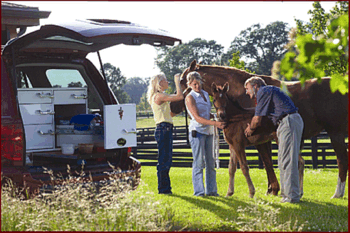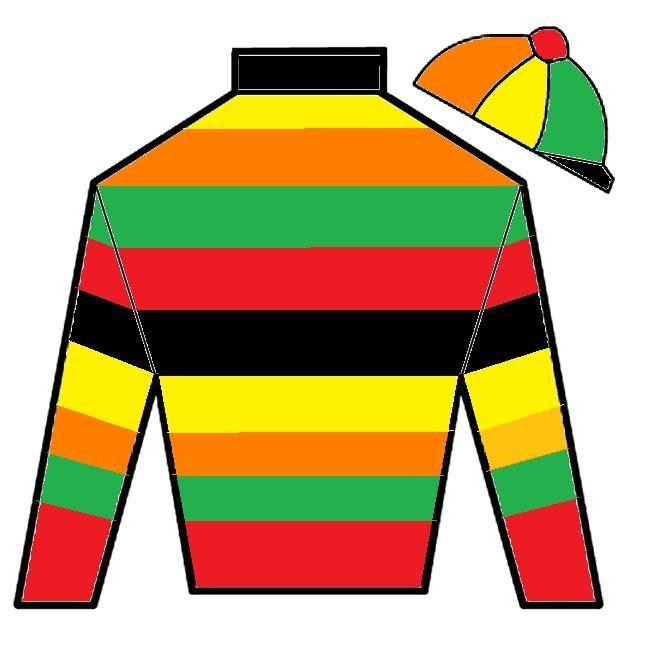|
Perhaps one
of the most necessary, elusive, frustrating, and often misunderstood
areas of
the Thoroughbred Racing Industry is the veterinary process. According to the Thoroughbred Owners of
California Owners’ Handbook: “The
average career of a professional football player is three years; while
the
average career of a racehorse is one and a half years.
These are fragile animals….”
 Like all
animals, race horses require medical attention for various
reasons before,
during, and after they are sent to the track. The
type of care that they receive depends upon the owner’s
stated
intentions, the trainer’s procedures, and the rules and
regulations that each
state mandates. Like all
animals, race horses require medical attention for various
reasons before,
during, and after they are sent to the track. The
type of care that they receive depends upon the owner’s
stated
intentions, the trainer’s procedures, and the rules and
regulations that each
state mandates.
Treatments
and associated costs are relative to what each horse needs to
remain
healthy. Understanding as much as
possible about the purpose of the care given, the cost, and
communication about
the do’s and don’ts of veterinary procedures is very
important to knowing about
your Runner’s health. Perhaps the
most
controversial area of veterinary care is the use of
medications—we’ll discuss
this topic after we cover the vet basics.
There are
common treatments and medications that all Thoroughbred racehorses
receive
during the course of their racing tenure. They
have scientific and generally accepted nicknames. The
charges for the services rendered can
vary by the vet, and the only standard is what the market will bear. As such, it is important to talk to your farm
manager and trainers about vet routines so, in the very least, you will
better
understand your horse’s health.
Routine
Procedures
De-worming
is necessary at least quarterly for parasite control.
Scoping is
the examination of the horse’s upper respiratory tract—with
particular
attention to the cartilage structures (i.e. the “flapper”)
in the throat that
opens and closes the airway. Vets use an
instrument called an endoscope (i.e. “scope”), which is
like a tiny video
camera attached to the end of a long, flexible hose.
The scope goes up the horse’s nose (a task
that requires skill and understanding of the horse’s temperament)
and into the
area of the throat to determine if there is physiological problem that
would
cause the horse to have a displaced flapper and essentially block its
airway. According to the Consignors
& Commercial Breeders Association (CBA), recent research studies by
Rood
& Riddle Equine Hospital in Lexington, KY have shown
that more than 98% of Yearlings had no throat
problems and horses graded IIa and IIb rate the same as horses graded I
(the
best). Scoping to detect verifiable
problems is necessary. In the same
light, a young horse’s airway is in a constant state of change,
and normal
throat deviations do not equate to lower performance on the racetrack.
 Radiographs (i.e., x-rays) are
utilized to examine the horse’s bone and joint structure,
development, and
condition. Depending on the vet, the
cost can vary for an x-ray consultation. Radiographs (i.e., x-rays) are
utilized to examine the horse’s bone and joint structure,
development, and
condition. Depending on the vet, the
cost can vary for an x-ray consultation.
Though
not
necessarily "vet-specific" categories, foot, hoof, and teeth
maintenance
are also
necessary procedures for a horse’s health. Diet, grooming,
and providing a safe/clean living environment
are also important to having a healthy horse.
Common
Conditions
Exercise-induced
pulmonary hemorrhage (i.e., EIPH or “bleeding”) occurs
when blood is present coming from the horse's nose during and/or
after intense training or racing. It looks like a nose
bleed, but the
source is actually the capillaries in the lungs. Simple EIPH
occurs as the natural consequence of the layout of the horse's organs;
the
way the equine body moves during high-speed galloping; and the elevated
blood pressure in the lungs. Nearly all
horses show at least some bleeding
within the lungs when running at full speed, and all race horses will
bleed
once or twice during their careers. The
back-and-forth
motion of galloping, and the stress of heavy breathing causes the tiny
blood
vessels in a horse's lungs to rupture. Also, airborne
contaminants (dirt, dust, extreme temperatures, etc.) and infections
can also
irritate the capillaries. The severity and frequency
of the condition's occurrence will determine the horse's ongoing
ability to compete.
Osteochondritis
Dissecans (OCD) is a condition seen in young horses when the cartilage
surface
of the growing long bones and joints fails to fully develop properly,
and
leaves cartilage at the surface where the bone should have hardened. The common procedures are to surgically remove
the soft spots (i.e., lesions) or let the normal development process
resolve
the OCD. At sale time, the presence of
OCDs can "scare off" potential buyers looking for clean x-rays; but the
good news
is that, in most cases, OCDs have a small effect on training and racing
performance. “When I bought Real
Quiet
for $17,000, I didn’t vet him. I
just
bought the athlete. I’ve had horses
that
didn’t pass the vet when they were yearlings and then went on to
become great
racehorses. Horses change and sometimes
it’s for the better, sometimes not.”—Bob Baffert.
Arthroscopic
surgery for a damaged knee, and/or removal of a bone or ankle chip has
also
become a “routine” procedure.
Sesamoiditis
is inflammation of the sesamoid bones—the
bones found at the back of the fetlock (ankle) that help to keep the
tendons
and ligaments that run between them correctly functioning.
Mild cases are treated with anti-arthritic
medications and rest.
Torn
suspensory ligaments and bowed tendons (i.e.,
Tendinitis) require months of rest, and medically there isn’t
much that can be
done to treat this problem. Typically,
horses that suffer from severe Tendinitis-related ailments are unable
to make a
succcessful come back.
Medications
The
use of medications to prevent illness and treat of
certain ailments are allowed for horse wellness and preparation for
competitive
racing. These include vaccinations,
anti-inflammatories, steriodes, antibiotics, vitamins, minerals, and
local
anesthetics. Adequan, Clenbuterol,
Furosemide
(i.e., Lasix), Equipoise, and Phenylbutazone (i.e., “bute”)
are a few common
medications that are used to treat cartilage, fluid in the lungs,
bleeding,
hormone deficincies, and inflammation respectively.
Only medications used to control bleeding are
allowed in all states during racing—all other drugs are not
permitted in
a horse’s system while in competition.
 Because horseracing is regulated by the
individual state
that conducts pari-mutuel wagering, each state’s procedures
for testing
racehorses vary widely and the “quality” depends upon
the level of funding set
aside in the state’s testing budget. Typically,
all horses that win, and those also selected by the racing
stewards, have to report to the test barn immediately following a
race to submit
a urine and blood sample, which is sent to a laboratory employed
by the racing
commission. Because horseracing is regulated by the
individual state
that conducts pari-mutuel wagering, each state’s procedures
for testing
racehorses vary widely and the “quality” depends upon
the level of funding set
aside in the state’s testing budget. Typically,
all horses that win, and those also selected by the racing
stewards, have to report to the test barn immediately following a
race to submit
a urine and blood sample, which is sent to a laboratory employed
by the racing
commission.
Lab
directors report that in 99 percent of test
“positives,” the drug found in the horse’s
system wasn’t intentional; but rather,
it wasn’t given properly or administered too close to race time. That said, the Industry is also faces
two greater problems that threaten the integrity of the sport:
- Owners willing
to push their horses beyond their competitieve abilities (i.e.,
encouraging Trainers to "win at all cost") using whatever medications
allowed to keep the horse on the track.
- Trainers who
play cat-and-mouse games with medications (permitted and not permitted)
in an attempt to boost the Runner’s stamina prior to a race.
The
challenge for most Trainers is understanding the withdrawl
periods for therapeutic medications and steriods; dosage; and
acceptable
administrative routes (i.e. orally, IV, etc.) for each state. The challenge for racing officials is
adopting uniform guidelines, rules, and procedures for the
testing/oversight process.
Trace
detection sensitivity is also a topic of debate. Studies
have been conducted that demonstrate
cases in which horses not given medications will test positive for drug
traces
due to contaminated transport stalls, test barns, and water containers. The Racing Medication and Testing Consortium
(RMTC) points out that the way the lab handles post-race samples has
been a “huge
problem” as well. This too places a big question mark over
the argument for "zero tolerance" drug-testing policies.
To
improve the consistency in medication standards and
procedures, the American Graded Stakes Committee has formally
implemented a
mandated drug-testing policy for all states who wish to conduct graded
stakes
races. The RMTC is trying raise
awareness and level the playing field by getting Industry leaders with
competing agendas to focus common interests - not an easy task when it
comes to getting 30 states to agree on the same thing.
As
an owner, the decisions about your horse’s health,
treatment, and welfare fall upon your shoulders. That's
why, it is important to discuss the veterinary procedures with your
Trainer,
and to stay informed on the latest Industry topics about medication
policies.
|










